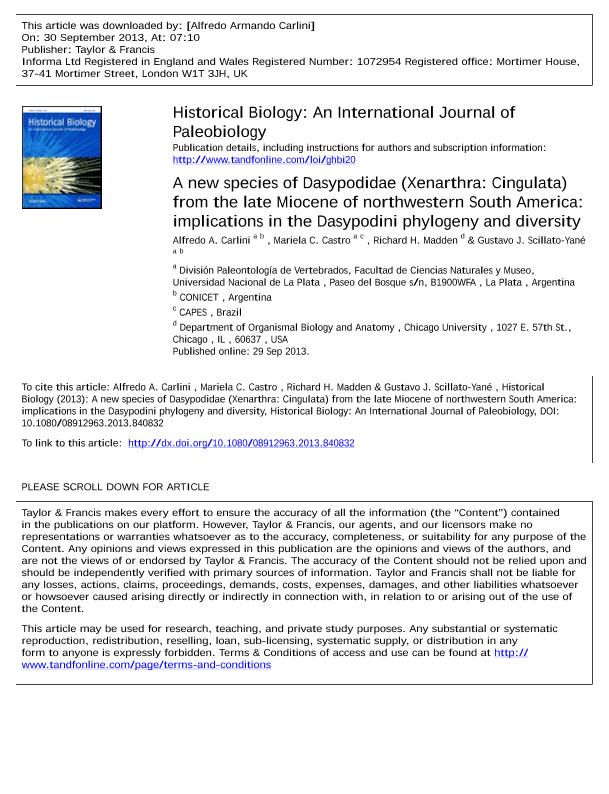Artículo
A new species of Dasypodidae (Xenarthra: Cingulata) from the late Miocene of northwestern South America: implications in the Dasypodini phylogeny and diversity
Fecha de publicación:
2014
Editorial:
Taylor & Francis
Revista:
Historical Biology
ISSN:
0891-2963
Idioma:
Inglés
Tipo de recurso:
Artículo publicado
Clasificación temática:
Resumen
A new species of dasypodid armadillo (Xenarthra, Cingulata), Anadasypus aequatorianus, from the late Miocene of Ecuador is described. The remains were collected in sediments of the Letrero Formation, Nabón Basin, which is part of several intermontane basins related to Andean uplift. The genus represents the oldest record of Dasypodini, which also encompasses Propraopus (Pleistocene–early Holocene) and Dasypus (?Miocene–Recent). The new species is based on several osteoderms, which show more derived features than Anadasypus hondanus, from the middle Miocene of Colombia. In order to test the affinities of A. aequatorianus within Dasypodini, we conducted a cladistic analysis of 24 morphological characters for 10 taxa. The most parsimonious tree supports the generic attribution of the new species and places Anadasypus basal to Propraopus and Dasypus, agreeing with the stratigraphic evidence. The faunas from tropical Andean areas differ noticeably from the better-known assemblages of the classic South American sequences. In the case of dasypodines, their geochronological distribution shows that they were historically restricted to tropical and subtropical environments and the main cladogenetic events of the group probably occurred at lower latitudes. In this context, the taxon described herein fills important temporal and geographic gaps of early Neogene armadillos from intertropical areas.
Palabras clave:
Dasypodini Phylogeny
,
Dasypodidae
,
Ecuador
,
Diversity
Archivos asociados
Licencia
Identificadores
Colecciones
Articulos(CCT - LA PLATA)
Articulos de CTRO.CIENTIFICO TECNOL.CONICET - LA PLATA
Articulos de CTRO.CIENTIFICO TECNOL.CONICET - LA PLATA
Citación
Carlini, Alfredo Armando; Castro, Mariela C.; Madden, Richard H.; Scillato, Gustavo Juan; A new species of Dasypodidae (Xenarthra: Cingulata) from the late Miocene of northwestern South America: implications in the Dasypodini phylogeny and diversity; Taylor & Francis; Historical Biology; 24; 6; -1-2014; 728-736
Compartir
Altmétricas




